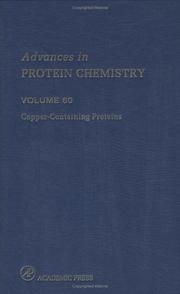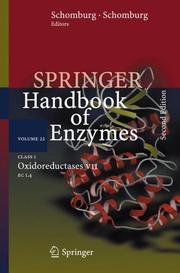| Listing 1 - 10 of 17 | << page >> |
Sort by
|
Book
Year: 2021 Publisher: London : IntechOpen,
Abstract | Keywords | Export | Availability | Bookmark
 Loading...
Loading...Choose an application
- Reference Manager
- EndNote
- RefWorks (Direct export to RefWorks)
Oxidoreductase enzymes are a group of enzymes that catalyzes the transfer of electrons from one molecule, the reductant, also called the electron donor, to another, the oxidant, also called the electron acceptor. Oxidoreductase enzymes utilize NADP+ or NAD+ as cofactors. Oxidoreductase enzymes include the following: oxidase, dehydrogenase, peroxidase, hydroxylase, oxygenase, and reductase. Most oxidoreductase enzymes are dehydrogenases. However, reductases are also common. The accepted nomenclature for dehydrogenases is "donor dehydrogenase", where the donor is the oxidized substrate. Metabolic abnormalities disorders resulting from a deficiency (quantitative and qualitative) or from over-activity of oxidoreductase, which may contribute to the decreased normal performance of life, are becoming common. This book covers the potential applications of oxidoreductases on the growth of oxidoreductase-based diagnostic tests and better biosensors in the design of inventive systems for crucial co-enzyme generations and in the synthesis of polymers and organic substrates. The book describes the role of oxidoreductase as essential in medical drug formation. It can be employed to produce a huge amount of compounds that act as medical mediators like Cephalosporin (beta lactam antibiotic). Furthermore, the idea of how to use different enzymes as targets for medical treatment in different types of cancers is also described in this book.
Book
ISBN: 1536105813 9781536105810 1536105503 9781536105506 Year: 2017 Publisher: New York : Nova Publishers,
Abstract | Keywords | Export | Availability | Bookmark
 Loading...
Loading...Choose an application
- Reference Manager
- EndNote
- RefWorks (Direct export to RefWorks)
Book
ISBN: 9535151991 9533070196 Year: 2012 Publisher: IntechOpen
Abstract | Keywords | Export | Availability | Bookmark
 Loading...
Loading...Choose an application
- Reference Manager
- EndNote
- RefWorks (Direct export to RefWorks)
The book takes in consideration some dehydrogenases, enzymes with different functions in the cells by using different substrates, such as hydroxysteroid dehydrogenases, aldehyde dehydrogenases, glucose-6-phosphate dehydrogenase, pyruvate dehydrogenase complex, glutamate dehydrogenase, succinate dehydrogenase. They are examined from the following points of view: biochemistry, physiological functions and role in some diseases and in the development of tumours. For these reasons, the book is divided into three sections: 1. Dehydrogenases and cancer 2. Dehydrogenases and some diseases 3. Dehydrogenases and physiological role
Book
Year: 2013 Publisher: Berlin ; Boston : De Gruyter,
Abstract | Keywords | Export | Availability | Bookmark
 Loading...
Loading...Choose an application
- Reference Manager
- EndNote
- RefWorks (Direct export to RefWorks)
The dynamic field of flavin and flavoprotein biochemistry has seen rapid advancement in recent years. This comprehensive two volume set provides an overview of all aspects of contemporary research in this important class of enzymes. Topics treated include flavoproteins involved in energy generation, signal transduction and electron transfer (including respiration); oxygen activation by flavoproteins; the biology and biochemistry of complex flavoproteins; flavin and flavoprotein photochemistry/photophysics as well as biotechnological applications of flavoproteins. Recent developments in this field include new structures (including those of large membrane-integral electron transfer complexes containing FMN or FAD), elucidation of the role of flavoproteins in cell signalling pathways (including both phototaxis and the circadian cycle) and important new insights into the reaction mechanisms of flavin-containing enzymes. This volume focusing on complex flavoproteins and physical methods is an essential reference for all researchers in biochemistry, chemistry, photochemistry and photophysics working on flavoenzymes.
Flavoproteins. --- Oxidoreductases. --- Biochemistry. --- Flavin. --- Photochemistry. --- Photophysics.

ISBN: 012034260X 9786611024864 1281024864 0080544061 9780120342600 Year: 2002 Publisher: New York, NY ; London : Academic Press,
Abstract | Keywords | Export | Availability | Bookmark
 Loading...
Loading...Choose an application
- Reference Manager
- EndNote
- RefWorks (Direct export to RefWorks)
A wide range of researchers are currently investigating different properties and applications for copper-containing proteins. Biochemists researching metal metabolism in organisms ranging from bacteria to plants to animals are working in a completely different area of discovery than scientists studying the transportation and regulation of minerals and small molecule nutrients. They are both working with copper-containing proteins, but in very different ways and with differing anticipated outcomes.
Copper proteins. --- Oxidoreductases. --- Enzymes --- Cuproproteins --- Metalloproteins --- Organocopper compounds
Book
ISBN: 1634854810 9781634854818 9781634854603 1634854608 Year: 2016 Publisher: New York : Nova Biomedical,
Abstract | Keywords | Export | Availability | Bookmark
 Loading...
Loading...Choose an application
- Reference Manager
- EndNote
- RefWorks (Direct export to RefWorks)
Superoxide dismutase. --- Cerebrocuprein --- Erythrocuprein --- Hemocuprein --- Manganese enzymes --- Oxidoreductases
Book
Year: 2019 Publisher: Frontiers Media SA
Abstract | Keywords | Export | Availability | Bookmark
 Loading...
Loading...Choose an application
- Reference Manager
- EndNote
- RefWorks (Direct export to RefWorks)
This eBook is a collection of articles from a Frontiers Research Topic. Frontiers Research Topics are very popular trademarks of the Frontiers Journals Series: they are collections of at least ten articles, all centered on a particular subject. With their unique mix of varied contributions from Original Research to Review Articles, Frontiers Research Topics unify the most influential researchers, the latest key findings and historical advances in a hot research area! Find out more on how to host your own Frontiers Research Topic or contribute to one as an author by contacting the Frontiers Editorial Office: frontiersin.org/about/contact
Actinomycetes --- functional annotation --- High GC genetics --- Novel biocatalysts --- Extremophile actinobacteria --- secondary metabolites --- Oxidoreductases
Book
Year: 2016 Publisher: Frontiers Media SA
Abstract | Keywords | Export | Availability | Bookmark
 Loading...
Loading...Choose an application
- Reference Manager
- EndNote
- RefWorks (Direct export to RefWorks)
The endoplasmic reticulum (ER) is an organelle crucial to many cellular functions and processes, including the mounting of T-cell immune responses. Indeed, the ER has a well-established central role in anti-tumor immunity. Perhaps best characterized is the role of the ER in the processing of antigen peptides and the subsequent peptide assembly into MHC class I and II molecules. Such MHC/tumor-derived peptide complexes are pivotal for the correct recognition of altered self or viral peptides and the subsequent clonal expansion of tumor-reactive T-cells. In line with the role of the ER in immunity, tumor-associated mutations in ER proteins, as well as ER protein content and localization can have both deleterious and advantageous effects on anti-tumor immune responses. For instance, loss of function of ER-aminopeptidases, that trim peptides to size for MHC, alter the MHC class I - peptide repertoire thereby critically and negatively affecting T-cell recognition. On the other hand, altered localization of ER proteins can have immune-promoting effects. Specifically, translocation of certain ER proteins to the cell surface has been shown to promote anti-tumor T-cell immunity by directing uptake of apoptotic tumor cells to professional antigen presenting cells, thereby facilitating anti-tumor T-cell immunity. These selected examples highlight a diverse and multi-faceted role of the ER in anti-tumor immunity. Molecular biological insights from the past decade have uncovered that ER components may affect tumor immunity and have invoked a variety of follow-up questions. For instance, how and why are ER proteins over-expressed in tumors? How do nucleotide and somatic mutations in ER chaperones/processing machinery affect the MHC/peptide complex and tumor cell immunogenicity? How do ER-proteins translocate to the cell surface? What if any is the potential role of extracellular ER protein in tumor immunotherapy/vaccines, and can they be delivered to the tumor cell surface by photodynamic therapy, anthracyclines or by other means? In this special research topics issue, we welcome basic and clinical research reports covering all aspects of ER proteins in cancer recognition by the immune system, therapy and drug development. We also welcome reports describing new insights into ER stress, signalling and homeostasis in immunogenic cell death in cancer, the effect of parasitic ER proteins on tumour growth, ER protein regulation of angiogenesis. Submission of original research articles, perspective, reviews and topical comments is encouraged. We aim to provide a comprehensive series of articles that will aid our understanding in a new and exiting avenue of tumour immunology and therapeutic development, exploiting a collection of proteins within the ER that are not obvious candidates for immunity to tumors.
Endoplasmic reticulum. --- Tumors --- Immunology. --- Oncology. --- Endoplasmic Reticulum Stress. --- Immunological aspects. --- Autoimmunity --- Angiogenesis --- T-cell receptors --- genome damage --- phage display --- Aminopeptidases --- Grp170 --- Oxidoreductases --- Vaccines --- chaperones
Book
ISBN: 3642445888 364212626X 9786612925535 3642126278 1282925539 Year: 2010 Publisher: Heidelberg ; New York : Springer,
Abstract | Keywords | Export | Availability | Bookmark
 Loading...
Loading...Choose an application
- Reference Manager
- EndNote
- RefWorks (Direct export to RefWorks)
This monograph describes many applications of peroxidase-based biocatalysis in the biotechnology industry. The need for such a book emerges from the considerable amount of new data regarding the phylogeny, reaction mechanisms, thermodynamic characterization and structural features of fungal and plant heme peroxidases that has been generated in the past 10 years, since the last specialized book on peroxidases was published. The aim of this book is to present recent advances on such basic aspects as evolution, structure-function relation and catalytic mechanism as well as applied aspects, such as bioreactor and protein engineering, to provide the tools for rational design of enhanced biocatalysts and biocatalytic processes.
Enzymes -- Biotechnology. --- Enzymes -- Industrial applications. --- Heme. --- Organic compounds -- Synthesis. --- Peroxidase. --- Peroxidases. --- Enzymes --- Biocatalysis --- Peroxidase --- Bioengineering --- Mechanical Engineering --- Engineering & Applied Sciences --- Industrial applications --- Enzymes. --- Biocatalysts --- Ferments --- Soluble ferments --- Chemistry. --- Biotechnology. --- Physical chemistry. --- Enzymology. --- Physical Chemistry. --- Catalysts --- Proteins --- Enzymology --- Hemoproteins --- Metalloenzymes --- Oxidoreductases --- Chemistry, Physical organic. --- Chemical engineering --- Genetic engineering --- Chemistry, Physical organic --- Chemistry, Organic --- Chemistry, Physical and theoretical --- Chemistry, Theoretical --- Physical chemistry --- Theoretical chemistry --- Chemistry --- Biochemistry

ISBN: 3540376461 3540238484 Year: 2005 Publisher: Berlin : Springer,
Abstract | Keywords | Export | Availability | Bookmark
 Loading...
Loading...Choose an application
- Reference Manager
- EndNote
- RefWorks (Direct export to RefWorks)
Springer Handbook of Enzymes provides data on enzymes sufficiently well characterized. It offers concise and complete descriptions of some 5,000 enzymes and their application areas. Data sheets are arranged in their EC-Number sequence and the volumes themselves are arranged according to enzyme classes. This new, second edition reflects considerable progress in enzymology: many enzymes are newly classified or reclassified. Each entry is correlated with references and one or more source organisms. New datafields are created: application and engineering (for the properties of enzymes where the sequence has been changed). The total amount of material contained in the Handbook has more than doubled so that the complete second edition consists of 39 volumes as well as a Synonym Index. In addition, starting in 2009, all newly classified enzymes are treated in Supplement Volumes. Springer Handbook of Enzymes is an ideal source of information for researchers in biochemistry, biotechnology, organic and analytical chemistry, and food sciences, as well as for medicinal applications.
Oxidoreductases. --- Enzymes --- Biocatalysts --- Ferments --- Soluble ferments --- Catalysts --- Proteins --- Enzymology --- Enzymes. --- Biochemistry. --- Analytical biochemistry. --- Biotechnology. --- Food science. --- Enzymology. --- Biochemistry, general. --- Analytical Chemistry. --- Food Science. --- Science --- Chemical engineering --- Genetic engineering --- Biological chemistry --- Chemical composition of organisms --- Organisms --- Physiological chemistry --- Biology --- Chemistry --- Medical sciences --- Analytic biochemistry --- Biochemistry --- Chemistry, Analytic --- Composition --- Bioanalytic chemistry --- Bioanalytical chemistry --- Analytical chemistry --- Analytical chemistry. --- Food—Biotechnology. --- Analysis, Chemical --- Analytic chemistry --- Chemical analysis
| Listing 1 - 10 of 17 | << page >> |
Sort by
|

 Search
Search Feedback
Feedback About UniCat
About UniCat  Help
Help News
News